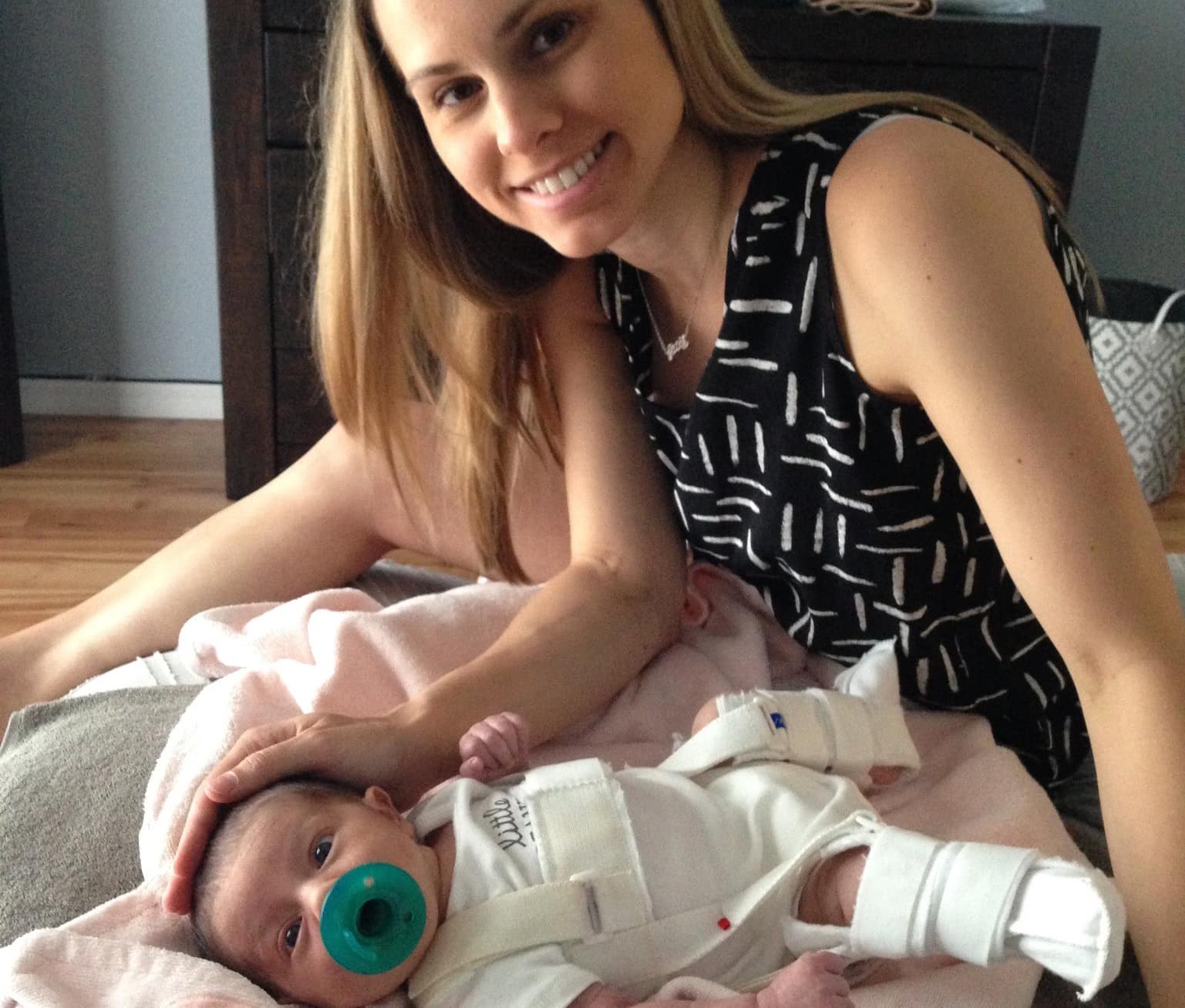Making Strides in Hip Dysplasia Research

When Tori Parr was born, the nurse heard the newborn’s left hip click.
A sonogram done when the infant was just one day old revealed she had hip dysplasia.
“Tori is our first born, female and was breech, which are all high risk factors for hip dysplasia,” says her mother Lauren Parr, an Orlando, Fla., attorney.
Tori went home from the hospital in a Pavlik harness, which she wore nonstop for a month to correct the condition. Now she is a nearly a year old and taking her first steps.
“We just had her one year appointment and her hips are still in place,” Lauren says. “We were very lucky. She didn’t have to have surgery.”
Not all babies born with hip dysplasia are so fortunate. Many infants, especially those with more severe cases or cases diagnosed late, do not see their condition corrected with the Pavlik harness, which is a much less invasive and costly alternative to surgery.
That is why Eduardo Divo and Victor Huayamave, who are researchers in Embry-Riddle Aeronautical University’s growing biomedical systems field, are investigating new ways to improve hip dysplasia treatment in infants. The research received funding from the International Hip Dysplasia Institute (IHDI) and the Paul B. Hunter and Constance D. Hunter Charitable Foundation.
“Severe developmental dysplasia of the hip is a condition for which we want to find a solution that is effective, inexpensive and does not involve surgery,” says Divo, Ph.D. program chair and interim department chair, Mechanical Engineering.
Working in collaboration with IHDI and University of Central Florida (UCF) faculty, Divo and Huayamave are using 3-D computer modeling to simulate hip dysplasia reduction dynamics with the Pavlik harness and also to look for different engineering solutions. The biomechanical research studies seek a better understanding of how various hip dysplasia treatments and positions affect the hips and to seek improvements in non-surgical treatments.
“The research being conducted at Embry-Riddle has a strong possibility of improving the mechanical function of modern braces,” says Charles Price, M.D, a pediatric orthopaedic surgeon and IHDI director. “It has real potential to extend non-surgical treatment to older children in addition to improving success rates for newborn infants.”
Collaborating to Meet a Global Need
Hip dysplasia is a condition where the hip socket is shallow or the wrong shape, resulting in the joint wearing out faster. Approximately two to three children per 1,000 need treatment for hip dysplasia, according to the IHDI.
Common in infants, hip dysplasia can range from mild instability that resolves spontaneously, to complete dislocation that may need surgery. The Pavlik harness is very effective for babies less than 6 months of age, when the hips are most malleable, Price says.
But many babies go undiagnosed. At 8 months, infants often need surgery, Price says, and after 18 months, every child needs surgery because bone deformity develops.
“The real sweet spot is to find a harness we can apply for children between 6 to 18 months of age,” Price says. “If we can improve nonsurgical treatment for those up to 18 months, then we’d have a huge difference and help the developing world. In the developing world, most children are not diagnosed until they are walking and have a limp.”
Divo and Huayamave are working with UCF engineering professors Alain Kassab and Faissal Moslehy on computer modeling aimed at improving the Pavlik harness to help more children with severe hip dysplasia. Exchanging files for a common database, the two teams are investigating multiple aspects of hip dysplasia.
“This project required a new way of looking at a medical problem,” Price says. “The engineers at Embry-Riddle are very innovative in this type of cross-disciplinary collaboration.”
Searching for Success for the Most Severe Cases
Additionally, Divo and Huayamave are the first to conduct a biomechanical analysis of bracing techniques, Price says. They are studying how babies are carried and the devices worn to carry them. They are then examining how the different mechanics impact baby hip development and hip dysplasia.
In research published by the Journal of Biomechanics, Divo, Huayamave and their colleagues computationally validated the usefulness of a non-surgical approach for reducing dysplasia. The technique – “hyperflexion” combined with external leg rotation – involves simply manipulating a baby’s leg and hip in a particular manner.
“The Pavlik harness is mainly built to treat and correct mild dislocations, but for severe cases, it just doesn’t work mechanically,” says Huayamave, assistant professor of mechanical engineering. “We're trying to use a combination of the harness, plus other methods, to help doctors successfully treat children with severe cases of hip dysplasia. One approach is hyperflexion of the hip.”
For the research, a 3-D model of a 10-week-old female baby was created, based on CT scans and MRIs, and researchers looked at five key adductor muscles, which pull body parts inward toward the midline. Their model indicated it is possible to achieve reduction of severe hip dysplasia by hyperflexion and resultant external rotation. This is significant, since the Pavlik harness effectively reduces lower grade hip dysplasia about 92 percent of the time, but has just a 2 percent reduction rate in patients with severe hip dysplasia.
Further Research Opportunities
Embry-Riddle researchers are also looking at different aspects of femoral anteversion (an inward twisting of the thigh bone) as related to reduction of dysplasia, Huayamave says.
Embry-Riddle students are also involved in the research as well, including graduate students Anthony Khoury and Jansyn Johnston.
“The human body doesn’t respond to the same engineering principles that materials do,” says Khoury. “It’s very complex and really keeps you on your toes.”
Johnston, president of the university’s Biomedical Engineering Society, says she likes that biomedical engineering has a direct impact on society.
“And there is a lot of variety,” she says. “It’s a large and broad field.”
Divo and Huayamave want to involve more students in their research. In May, they applied for the National Science Foundation (NSF) Research Experiences for Undergraduates program, which would provide about $300,000 to host 12 students. The research had previously received $340,000 in NSF funding, part of which Divo brought with him to Embry-Riddle in 2013.
Eventually, Embry-Riddle’s research could not only help infants, but adults, too. Nine out of 10 cases of hip dysplasia are diagnosed during adolescence or adulthood, Price says. This silent form of hip dysplasia is the most common cause of hip arthritis in women younger than 50, and the reason for up to 10 percent of all total hip replacements in the United States.
“Embry-Riddle’s modeling is very adaptable to the adult deficient hip,” Price says. “Hip dysplasia is definitely a crippling disorder and I can’t think of a single disorder that is so amenable to a mechanical cure. As a true mechanical disorder, this is it.”
EVENT NOTICE – Embry-Riddle researchers are engineering new ways to fight a crippling condition. Join them for a free SpeakER Series event tonight, Tuesday, Feb. 27 at 7 p.m. in the Willie Miller Instructional Center, Gale Lemerand Auditorium, on the Daytona Beach, Fla., campus. This event celebrates the launch of the spring 2018 edition of ResearchER magazine.
Editor’s Note: This article was originally published in the spring 2018 edition of ResearchER magazine (Vol. 2, No. 1). The ResearchER archives can be found on Scholarly Commons.

 Melanie Stawicki Azam
Melanie Stawicki Azam